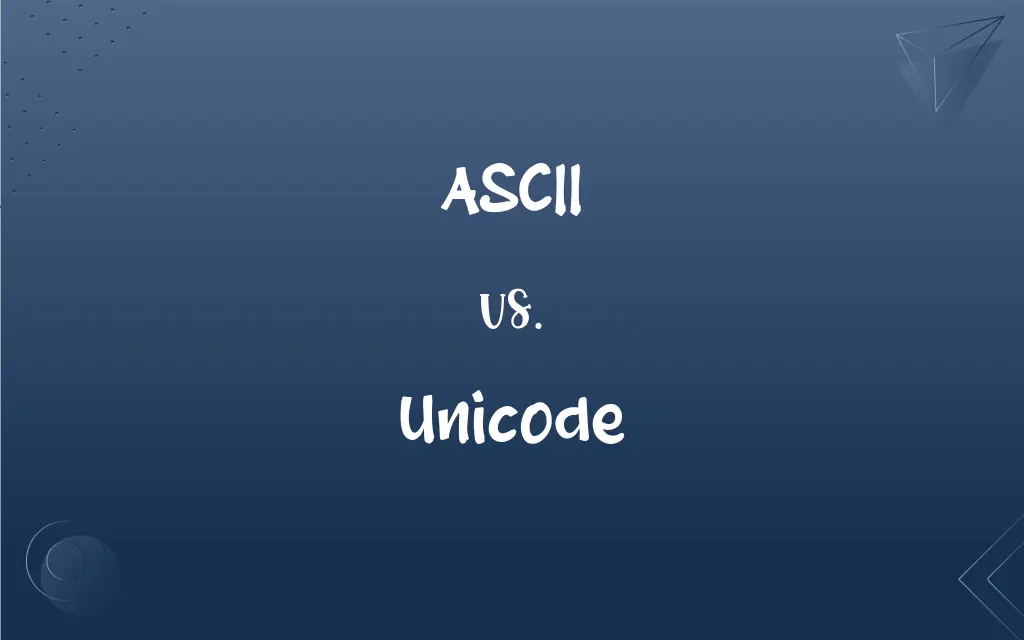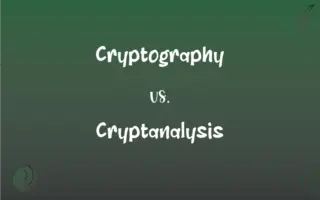ASCII vs. Unicode: What's the Difference?
Edited by Harlon Moss || By Janet White || Published on January 25, 2024
ASCII is a character encoding standard for English, representing 128 characters, while Unicode supports over 143,000 characters globally.

Key Differences
ASCII, short for American Standard Code for Information Interchange, is a character encoding standard initially designed to represent characters in the English alphabet. It uses 7 bits to represent each character, allowing for 128 unique characters, including letters, digits, and control characters. In contrast, Unicode is a comprehensive encoding system designed to represent characters from virtually all writing systems around the world. It can encode over 143,000 characters and uses variable byte sizes, typically ranging from 8 to 32 bits.
The primary purpose of ASCII was to standardize how computers represent and communicate text, particularly for telecommunication and computing devices in the English-speaking world. ASCII's limited character set, however, made it inadequate for global communication, which led to the development of Unicode. Unicode, with its extensive character set, supports multiple languages and scripts, including those that require complex right-to-left or top-to-bottom writing systems.
When considering character representation, ASCII maps each character to a number between 0 and 127, covering basic English letters, numerals, punctuation marks, and control characters. Unicode, on the other hand, assigns a unique code point to every character, no matter the language or script, within a much larger range, starting from 0 to over a million potential code points. This vast range of Unicode accommodates a diverse array of alphabets, symbols, and even emojis.
In terms of compatibility and usage, ASCII enjoys widespread support in older systems and software, being integral to the foundations of modern computing. However, its limitations in terms of international language support have made Unicode the preferred standard in globalized digital environments. Unicode's compatibility with multiple byte encodings, like UTF-8, UTF-16, and UTF-32, allows it to be versatile and universally accepted across different platforms and technologies.
Regarding technical implementation, ASCII is simpler and more straightforward, given its smaller size and fixed bit length. This simplicity translates to ease of use in programming and data processing for English-based applications. Unicode, while more complex due to its larger size and variable encoding formats, provides the necessary framework for multilingual computing and internationalization of software applications, making it indispensable in today's interconnected world.
ADVERTISEMENT
Comparison Chart
Character Range
Limited to 128 characters
Over 143,000 characters
Bit Encoding
7 bits per character
Variable (8 to 32 bits)
Language Support
Primarily English
Global languages and scripts
Code Point Range
0 to 127
0 to 1,114,111
Primary Use
English computing and telecommunication
Multilingual and global computing
ADVERTISEMENT
ASCII and Unicode Definitions
ASCII
An early computer encoding system for text representation.
ASCII codes are essential in programming.
Unicode
An extensive coding system for text representation.
Unicode is essential for displaying diverse languages on the web.
ASCII
A foundational text encoding in computing.
ASCII was the backbone of early text files.
Unicode
An encoding standard that transcends linguistic barriers.
Unicode made it possible to mix scripts within a single document.
ASCII
A 7-bit character encoding standard for English.
The ASCII value for 'A' is 65.
Unicode
The go-to encoding for modern multilingual computing.
Unicode is crucial for software localization and internationalization.
ASCII
A basic character set for digital communication.
ASCII revolutionized data transmission in its era.
Unicode
A comprehensive system for digital text that accommodates global scripts.
Unicode supports the complexities of Asian and Middle Eastern scripts.
ASCII
A protocol for representing English characters as numbers.
ASCII allows computers to translate human-readable text into machine-readable format.
Unicode
A universal character encoding standard supporting multiple languages.
Unicode includes characters from almost every written language.
ASCII
A standard for assigning numerical values to the set of letters in the Roman alphabet and typographic characters.
Unicode
A character encoding standard for computer storage and transmission of the letters, characters, and symbols of most languages and writing systems.
ASCII
Persons who, at certain times of the year, have no shadow at noon; - applied to the inhabitants of the torrid zone, who have, twice a year, a vertical sun.
ASCII
The American Standard Code for Information Interchange, a code consisting of a set of 128 7-bit combinations used in digital computers internally, for display purposes, and for exchanging data between computers. It is very widely used, but because of the limited number of characters encoded must be supplemented or replaced by other codes for encoding special symbols or words in languages other than English. Also used attributively; - as, an ASCII file.
ASCII
(computer science) a code for information exchange between computers made by different companies; a string of 7 binary digits represents each character; used in most microcomputers
FAQs
Is ASCII still used today?
ASCII is still used, especially in legacy systems and for basic English text representation.
What is ASCII?
ASCII is a character encoding standard for English, using 7 bits to represent 128 characters.
Can Unicode represent all world languages?
Unicode can represent characters from almost all written languages.
What is Unicode?
Unicode is a universal character encoding system supporting over 143,000 characters globally.
What's the main advantage of Unicode over ASCII?
The main advantage of Unicode is its ability to represent a vast array of global characters and symbols.
Is Unicode compatible with ASCII?
Unicode is designed to be backward compatible with ASCII.
Why was ASCII replaced by Unicode?
ASCII was replaced by Unicode to accommodate a wider range of characters and languages.
How do ASCII and Unicode differ in terms of character range?
ASCII has a limited range of 128 characters, while Unicode has over 143,000.
Can ASCII encode emojis?
No, ASCII cannot encode emojis; Unicode is required for that.
How many bits does Unicode use?
Unicode uses variable bit lengths, typically ranging from 8 to 32 bits.
Which encoding is preferred for web content, ASCII or Unicode?
Unicode is preferred for web content due to its extensive language support.
What are the benefits of using Unicode in programming?
Unicode's benefits in programming include support for internationalization and handling of diverse character sets.
What is the maximum number of characters ASCII can represent?
ASCII can represent a maximum of 128 characters.
How does Unicode handle different language scripts?
Unicode assigns unique code points to each character of different scripts, accommodating their specific needs.
What is the ASCII value of the character 'A'?
The ASCII value of 'A' is 65.
Are ASCII and Unicode compatible in all software?
Most modern software supports both, but some legacy systems may only support ASCII.
How does Unicode affect file sizes compared to ASCII?
Unicode files may be larger than ASCII due to more extensive character representation, especially when using encodings like UTF-16 or UTF-32.
Is learning about ASCII still relevant for programmers?
Yes, understanding ASCII is still relevant, especially for foundational knowledge and working with legacy systems.
How does Unicode support complex scripts like Arabic?
Unicode includes special code points and rules for right-to-left scripts and script-specific features.
Can ASCII represent non-English characters?
ASCII is limited to English characters and cannot natively represent characters from other languages.
About Author
Written by
Janet WhiteJanet White has been an esteemed writer and blogger for Difference Wiki. Holding a Master's degree in Science and Medical Journalism from the prestigious Boston University, she has consistently demonstrated her expertise and passion for her field. When she's not immersed in her work, Janet relishes her time exercising, delving into a good book, and cherishing moments with friends and family.
Edited by
Harlon MossHarlon is a seasoned quality moderator and accomplished content writer for Difference Wiki. An alumnus of the prestigious University of California, he earned his degree in Computer Science. Leveraging his academic background, Harlon brings a meticulous and informed perspective to his work, ensuring content accuracy and excellence.






































































